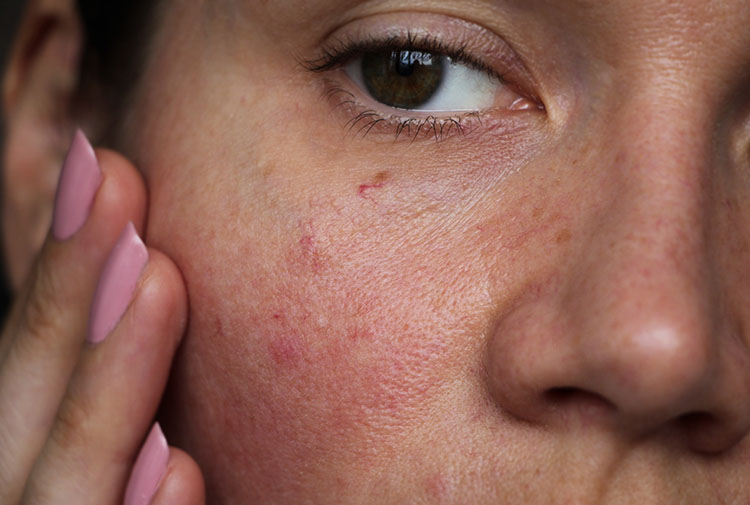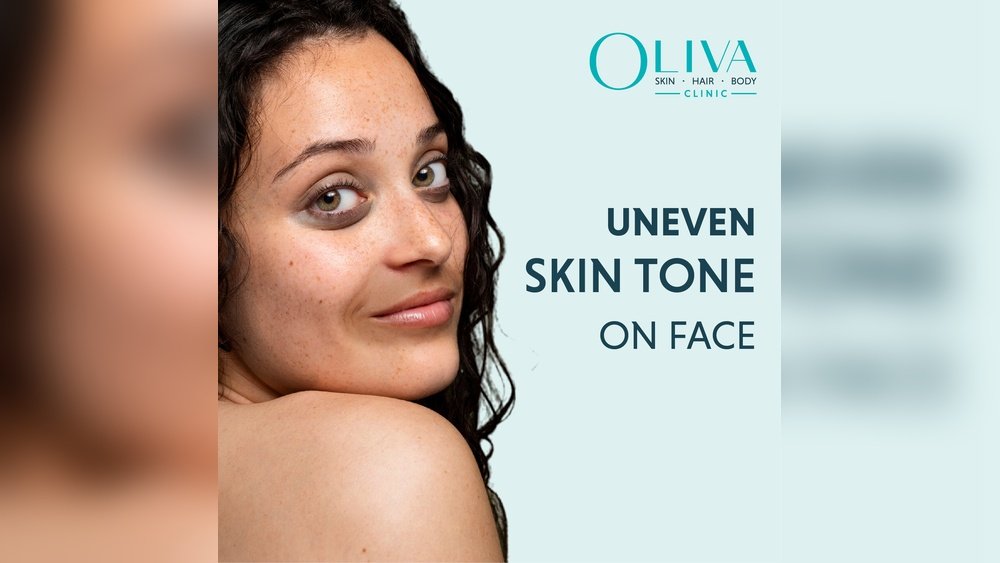Do you ever look in the mirror and wonder why your cheeks feel rough or look uneven? Uneven skin texture on your cheeks can be frustrating, especially when you want your skin to feel smooth and look radiant.
But what causes this bumpy, rough, or dull appearance? It’s not just one thing—several factors like dead skin buildup, sun damage, aging, or even stress can affect how your skin feels and looks. Understanding these causes is the first step to restoring your skin’s natural glow.
Keep reading to discover why your cheek skin might be uneven and what you can do to smooth it out for good.
:max_bytes(150000):strip_icc()/SkinTexture-b6405c638d3a4843bbe120dc752b1276.jpg)
Credit: www.health.com
Common Skin Texture Issues
Uneven skin texture on cheeks is a common concern. Many people notice roughness, bumps, or enlarged pores. These issues affect how smooth and healthy the skin looks. Understanding common skin texture problems helps identify the causes and find solutions.
Dead Skin Cell Buildup
Old skin cells can pile up on the surface. This buildup makes skin feel rough and look dull. It blocks pores and causes small bumps. Regular exfoliation removes these dead cells and smooths the skin.
Sun Damage
Sun exposure harms skin cells and breaks down collagen. This damage reduces skin elasticity and smoothness. Over time, skin may become rough and uneven. Using sunscreen protects skin and prevents further damage.
Dry Skin
Dry skin lacks moisture and can feel flaky or rough. It often causes small, uneven patches on the cheeks. Hydrating creams and gentle cleansers help restore moisture and soften the skin.
Clogged Pores And Milia
Pores can get clogged with oil and dirt. This leads to bumps and uneven texture on the cheeks. Milia, small white cysts, also cause rough spots. Proper cleansing and treatments clear pores and reduce bumps.
Aging Skin
Aging slows down skin renewal and reduces moisture. Loss of collagen and elastin makes skin less smooth. Fine lines and rough patches appear more easily. Using anti-aging products can improve texture and firmness.

Credit: www.drpeterkay.com
Dead Skin And Clogged Pores
Dead skin and clogged pores often cause uneven skin texture on cheeks. Our skin naturally sheds old cells, but sometimes these dead cells do not fall off properly. This accumulation creates a rough and dull surface on the skin.
Clogged pores happen when oil, dirt, and dead skin block the pores. These blockages stop the skin from breathing and renewing itself. Over time, this leads to bumps, blackheads, and uneven skin texture.
How Dead Skin Affects Skin Texture
Dead skin cells build up on the skin’s surface. This build-up makes the skin look rough and flaky. It also blocks natural oils from moisturizing the skin. Without proper removal, dead skin can cause dullness and uneven patches.
Causes Of Clogged Pores On Cheeks
Excess oil, dirt, and sweat can clog pores easily. Using heavy skincare or makeup products may worsen the problem. Pollution and sweat increase the chances of pore blockage. Clogged pores often show as tiny bumps or blackheads on cheeks.
Preventing Dead Skin And Clogged Pores
Regular gentle exfoliation removes dead skin cells. Cleansing the face twice daily helps keep pores clear. Choosing non-comedogenic skincare products reduces pore blockage. Keeping the skin hydrated supports healthy cell turnover.
Sun Damage Effects
Sun damage is a major cause of uneven skin texture on the cheeks. The sun’s ultraviolet (UV) rays harm skin cells. This damage changes how skin feels and looks. Over time, skin loses its smoothness and becomes rougher.
Repeated sun exposure breaks down collagen. Collagen keeps skin firm and elastic. Without enough collagen, skin sags and forms bumps. These changes create an uneven texture that is noticeable on cheeks.
How Uv Rays Affect Skin Cells
UV rays penetrate the skin deeply. They harm the DNA inside skin cells. Damaged cells cannot repair themselves well. This slows down the skin’s natural renewal process. Dead skin cells build up on the surface, making skin feel rough.
Loss Of Collagen And Elastin
Collagen and elastin give skin strength and bounce. Sun damage breaks these fibers down faster than normal. Skin loses firmness and smoothness. This creates fine lines and rough patches on cheeks.
Dryness And Flaking
Sun exposure dries out the skin. It strips away natural oils that keep skin soft. Dry skin flakes and peels, causing uneven texture. This dryness makes cheeks look dull and rough.
Formation Of Sunspots And Bumps
Sun damage triggers dark spots called sunspots. These spots change skin color unevenly. The skin may also develop small bumps from thickened areas. Both spots and bumps add to uneven skin texture.
Hormones And Aging Impact
Hormones and aging play a crucial role in the texture of skin on your cheeks. Changes inside the body affect skin’s smoothness and appearance. These changes often lead to uneven skin texture, making cheeks look rough or bumpy.
Hormones influence oil production and skin cell turnover. Fluctuations, especially during puberty, pregnancy, or menopause, can cause the skin to feel uneven. Aging reduces the skin’s ability to repair itself and keep moisture. This results in dryness and rough patches on the cheeks.
Hormonal Changes And Skin Texture
Hormonal shifts can increase oil production. Excess oil may clog pores and cause bumps or roughness. Hormones also affect how skin cells renew. Slower cell turnover leads to buildup of dead cells, causing uneven texture.
Aging Effects On Skin Smoothness
As skin ages, collagen and elastin break down. These proteins keep skin firm and smooth. Loss of collagen causes skin to sag and develop fine lines. Dryness increases, making skin feel rough or flaky.
Menopause And Skin Texture
During menopause, estrogen levels drop sharply. This hormone loss reduces skin moisture and elasticity. Cheeks may become drier and less supple. Uneven texture is common as skin thins and loses glow.
Impact Of Hormones On Pores
Hormonal changes can enlarge pores on the cheeks. Larger pores trap dirt and oil more easily. This leads to bumps and rough skin. Keeping pores clean is harder when hormones are unbalanced.
Lifestyle And Environmental Factors
Uneven skin texture on cheeks often results from lifestyle and environmental factors. These elements affect the skin’s health and appearance daily. Understanding these causes helps in managing and improving skin texture effectively.
Lack Of Proper Hydration
Not drinking enough water dries out the skin. Dry skin looks rough and uneven. Hydrated skin stays smooth and soft. Water helps flush out toxins that harm skin cells.
Sun Exposure
Sunlight damages skin cells and breaks down collagen. This damage leads to rough patches and bumps. Using sunscreen protects the skin from harmful UV rays. Avoiding long sun exposure keeps skin texture even.
Poor Diet Choices
Eating many processed and sugary foods affects the skin negatively. These foods cause inflammation and clogged pores. A balanced diet rich in fruits and vegetables supports healthy skin. Nutrients from food help repair and smooth skin texture.
Pollution And Environmental Toxins
Pollution deposits dirt and toxins on the skin. This buildup clogs pores and causes irritation. Regular cleansing removes pollutants and keeps skin clear. Clean air and indoor plants can reduce toxin exposure.
Stress And Lack Of Sleep
Stress increases oil production and inflammation in the skin. Poor sleep slows down skin repair processes. Both factors lead to uneven and dull skin texture. Rest and relaxation promote smoother and healthier skin.

Credit: riopellecosmetic.com
Simple Skincare Fixes
Simple skincare fixes can improve uneven skin texture on your cheeks. They help smooth rough patches and boost skin glow. Consistent care makes a big difference. Small changes in your routine bring visible results.
Focus on gentle cleansing, regular exfoliation, and proper moisturizing. These steps remove dead skin and keep skin soft. Sun protection also plays a key role in preventing texture issues.
Gentle Cleansing To Remove Impurities
Cleanse your face twice daily with a mild cleanser. Avoid harsh soaps that dry out your skin. Clean skin allows better absorption of treatments. It helps prevent clogged pores and bumps.
Exfoliation To Smooth Rough Skin
Exfoliate 2-3 times a week to remove dead skin cells. Use gentle scrubs or chemical exfoliants like AHAs or BHAs. This encourages new skin growth and reduces rough patches. Over-exfoliating can irritate skin, so keep it mild.
Moisturizing For Hydration And Softness
Apply a moisturizer suited for your skin type daily. Moisturizers help keep skin hydrated and plump. Hydrated skin looks smoother and less uneven. Use products with ingredients like hyaluronic acid or ceramides.
Sun Protection To Prevent Damage
Apply sunscreen every day, even on cloudy days. UV rays break down collagen and worsen skin texture. Use broad-spectrum sunscreen with at least SPF 30. Reapply sunscreen every two hours outdoors for best protection.
Frequently Asked Questions
Why Is The Skin Texture Uneven On My Cheeks?
Uneven skin texture on cheeks results from dead skin buildup, sun damage, aging, clogged pores, and dehydration. Regular exfoliation and moisturizing improve smoothness.
Why Am I Suddenly Getting So Much Texture On My Face?
Sudden facial texture often results from stress, hormones, dehydration, pollution, or aging. Excess oil and dead skin cells clog pores, causing bumps and roughness.
How Do You Fix Uneven Skin On Your Face?
Fix uneven facial skin by exfoliating regularly, moisturizing daily, using sunscreen, and maintaining a clean diet. Consider facials and suitable skincare products.
Why Does My Face Have Different Textures?
Different face textures result from dead skin buildup, sun damage, clogged pores, aging, dehydration, and hormonal changes affecting skin smoothness.
Conclusion
Uneven skin texture on cheeks comes from many causes. Dead skin cells and sun damage often play a big role. Aging and dehydration also make skin rougher. Stress and pollution can worsen the problem too. Treating your skin gently helps improve its feel and look.
Use simple skincare steps like cleansing, moisturizing, and exfoliating regularly. Eating healthy and staying hydrated supports better skin health. Understanding what causes your skin texture helps you care for it well. Small changes make a noticeable difference over time. Keep patience and care for smoother, healthier cheeks.
 Skip to content
Skip to content 